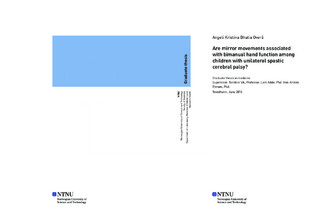| dc.description.abstract | Children and adolescents with unilateral spastic cerebral palsy (USCP) may experience
mirror movements (MM). The amount of MM may indicate differences in the
organization of the cortico-spinal motor tracts, which may in turn affect the
effectiveness of interventions aimed to improve hand function. However, it is unclear if
MM affect bimanual hand function in this population.
AIM:
This study aimed to assess whether MM affected bimanual hand function in children
with USCP.
METHOD:
Eligible to participate in this study, were children and adolescents with USCP. Children
and adolescents were recruited from two sites: In Trondheim, Norway, a convenient
sample of 18 children and adolescents (9 females; age range 12-20 y, mean 12.2 y) was
recruited through the outpatient clinic. In Melbourne, Australia, further 18 patients
with USCP participating in an on-going research project were recruited. Since the latter
population, in several important aspects, turned out to be markedly different, from
those recruited from the site in Trondheim, the present study was restricted to the
Trondheim population. Bimanual performance was scored using the Assisting Hand
Assessment (AHA), and manual capacity was scored using the Box and Block test (B&B).
Mirror movements were scored clinically according to Woods and Teuber (W&T) based
on video recordings. In addition, MM were assessed using a newly developed computerbased
video analysis software. Mirror movements were then correlated with hand
function.
RESULTS:
When MM were scored according to W&T, moderate to high negative correlations were
found between MM and all measures of hand function (Spearmans’s rho ranging from -
0.50 to -0.66). When MM were measured using the computer-based method, only a low to moderate negative correlation was found between MM and capacity (B&B) in the
affected hand (Spearman’s rho = -0.50).
INTERPRETATION:
Mirror movements in the affected and in the non-affected hand, affects bimanual
performance and capacity in both hands negatively among children over the age of 10.
Remove selected | nb_NO |
